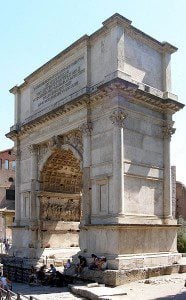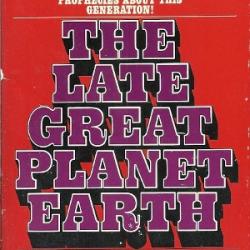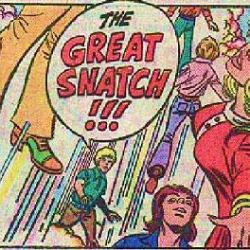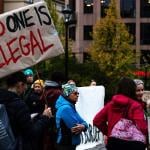Nicolae: The Rise of Antichrist; pp. 287-292
In hole in the ground lived a rabbi …
Wait, I’m getting ahead of myself there. Before we follow Buck Williams in these pages on his tour of the super-secret underground shelter Bruce Barnes constructed beneath his suburban church, we should first consider what this holy hidey hole is for. The idea, Bruce said, was to provide a safe place where Christians could flee when the Antichrist begins persecuting the church.
Now, there are some rather big, um, holes in Bruce’s plan here — some significant, potentially lethal, oversights in his dig-a-hole-and-hide strategy. But before we deal with the logical holes in Bruce’s planned response to the Antichrist’s persecution of the church, we first need to discuss the logical hole at work in the tenet of “Bible prophecy” that “prophesies” that, in the Last Days, the Antichrist will persecute the church.
This is one of the many places in which the Bible doesn’t readily cooperate with Tim LaHaye’s “Bible prophecy” scheme. LaHaye insists he reads the Bible “literally,” but his literal interpretation always takes a lot of work because it’s a literal reading of the text in support of an idea that literally can’t be found within its pages — the idea that it’s mainly about a series of events that won’t take place until 2,000+ years later.
Consider, for example, Tim LaHaye’s idea that the future Antichrist will desecrate and then destroy the Temple in Jerusalem. That’s a problem because there hasn’t been a Temple in Jerusalem for more than 1,900 years. So in order to “literally” interpret every biblical reference to the destruction of the Temple as a prediction of the distant future, LaHaye has to add something the Bible itself doesn’t say. He has to look between the lines to find, or to invent, an implicit, hidden prophecy that the Temple in Jerusalem will one day in the future be rebuilt in order that a coming Antichrist will, one day in the future, have the opportunity to desecrate and destroy it all over again.
This is all based on a bunch of passages that refer to the destruction of the Temple. Those passages — wrested mainly from Daniel and from the Gospels — seem to refer to the actual desecration and destruction of the actual Temple, a literal event that has already literally occurred, twice, in actual history.
Outside the confines of Tim LaHaye’s “Bible prophecy” mystery cult, there’s a fascinating argument about those biblical passages. Some argue that they were “prophetic” in the modern, predictive sense of the word — meaning that they were written before the destruction of the first and second temples by inspired writers who foresaw and foretold the events that thereafter came to pass. Others, a bit more convincingly, argue that these passages were written after those events in an effort to discern the theological meaning of those calamities.

That’s why 70 CE is such an important date in biblical studies. That was the year in which Roman soldiers under Emperor Titus destroyed Jerusalem and the Temple — an overwhelming, world-changing event for first-century Jews and Christians. The earliest New Testament texts, the epistles of Paul, were written before that event and don’t mention it at all. But later texts, such as the Gospel of Matthew, include many references to the Temple’s destruction. That leads most scholars to argue that Matthew was written some time after 70 CE, while some others argue that it was written earlier and that its references to the events of 70 CE were “prophetic” predictions of the horrors that were about to occur.
If you’re into that kind of thing, that dispute really is fascinating, but my main point here is that both sides of that argument disagree with the odd belief taught here in the Left Behind books, which is that the actual destruction of the actual Temple in Jerusalem that actually happened in 70 CE has nothing to do with the Gospel texts that allude to the Temple’s destruction. Those texts, Tim LaHaye says, aren’t about the Temple that Jesus walked in and that Titus’ troops destroyed. Those texts are, instead, about a future Temple, one that hadn’t even been built yet and that, today, in 2014, still has not yet been built. For LaHaye, when Jesus spoke of the Temple, he didn’t mean the actual Temple there in Jerusalem in whose actual shadow he was actually standing. He meant some future Temple that would be built on the same site 2,000 or so years in the future.
That’s a pretty wild assertion, and it only gets wilder when LaHaye attempts to justify it as a “literal” reading of the text.
But LaHaye encounters an even bigger problem when it comes to the topic we read about here in Chapter 14 of Nicolae. In this set of pages, Buck Williams returns to New Hope Village Church to inspect Bruce’s secret underground shelter. This hidden sub-basement is where Buck hopes to hide his friend Tsion Ben-Judah. There Tsion will be safe from the Antichrist’s anti-Christian police force while using the shelter’s untraceable Internet connection to preach the gospel to the entire world (or, at least, to the entire World Wide Web).
This is all in accordance with what Tim LaHaye says the Bible prophesies in the book of Revelation. That book, he says, foretells spectacular growth for the church while, at the same time, predicting that the church will face harsh persecution and martyrdom at the hands of the Antichrist.
And that, again, is a bit of a problem for LaHaye’s “Bible prophecy” scheme. In his “prophetic” timeline, the “Rise of the Antichrist” occurs only now, at the beginning of what he calls the Great Tribulation. That seven-year period of divine wrath and judgment begins after the Rapture of the church.
You see the problem here? Let’s spell it out more clearly. Here’s the sequence of events in LaHaye’s prophecy:
1. The Rapture of the church. The entire church is whisked off to Heaven.
2. The Rise of the Antichrist.
3. The persecution of the church by the Antichrist.
Hmm. The only way for Prophesied Future Event No. 3 to follow after PFE No. 1 is to insert something else — Prophesied Future Event No. 2a, the rebuilding of the church from scratch. In Tim LaHaye’s scheme the church, like the Temple, will need to be hastily rebuilt and reconstructed in the Last Days, just so that it can subsequently be persecuted/torn-down all over again by a future Antichrist. Just as the “Temple” spoken of in Matthew’s Gospel wasn’t a reference to the Temple that Jesus, and Matthew, and everyone that the author of Matthew was writing for would have thought of as the Temple, so too the “church” and the “churches” that John of Patmos wrote about in Revelation had nothing to do, according to LaHaye, with the actual church and churches that John and all of the people he was writing to would have in mind when they saw that word “church.”
Sure, yes, shortly before the Gospel of Matthew was written (or, perhaps, shortly after), the Temple and the city of Jerusalem were destroyed. But according to Tim LaHaye, that’s not what those bits in Matthew about the destruction of the Temple and of Jerusalem were really about. They were really about the future destruction, thousands of years later, of another Temple — one that still does not yet exist. The actual destruction of the actual Temple in the first century was just foreshadowing of the future destruction of the as-yet-unbuilt future Temple.
And sure, yes, before and during and after the time that John of Patmos wrote the book of Revelation, the church suffered from persecution at the hands of the empire. But according to LaHaye, that church, persecution and empire weren’t really what Revelation was talking about when it mentions the persecution of the church by the empire. Those passages are really about a different persecution of a different church by a different empire — none of which would exist until thousands of years later in the distant future. The actual persecution of the actual church by the actual empire was merely foreshadowing of the future persecution of the reconstituted post-Rapture church by the future empire of the future Antichrist.
This is, again, what Tim LaHaye means when he says he reads the Bible “literally.”
Like all his fellow “Bible prophecy” scholars, LaHaye insists that the Rapture is imminent. At any second now, the entire church will be snatched away to Heaven in the twinkling of an eye, leaving behind a world with neither church nor Temple.
This puts the Antichrist on a very tight schedule. He has a strict list of prophecies that are going to need fulfilling and that timeline is non-negotiable. Within three and a half years of the Rapture, the Antichrist is going to need to be persecuting a global church and he’s going to need to be desecrating a Temple in Jerusalem. And there, on Day One of the Great Tribulation, the morning after the Rapture, neither a global church nor a Temple will exist.
You almost have to feel sorry for Nicolae Carpathia when you consider everything he’s got on his plate. He has to build a one-world government with a single currency, language and religion. He has to rebuild the ruins of Babylon into a global capital and plan the worldwide implementation of the Mark of the Beast. And at the same time, he’s going to have to ensure that the Temple in Jerusalem is rebuilt and that a brand new global Christian church is created from scratch.
Frankly, he’s swamped.
I suppose the physical reconstruction of the structure of the Temple is probably the easy part — particularly compared to the challenge of turning a desert wasteland into New Babylon, a global capital city complete with hangars and headquarters for the entire global arsenal. Nicolae, after all, has the advantage of having, literally, all the money in the world at his disposal to ensure those projects are built on time. (Plus, it doesn’t really matter if the contractors cut corners a bit because neither New Babylon nor the new Temple needs to stand for more than a few years anyway.) The greater challenge with the Temple will be trying to re-spool nearly 2,000 years of Jewish tradition in order to go back to the priestly religion of the Second Temple period.
For those keeping score, that’s three major religions that Nicolae is going to need to reinvent, from the ground up, in just a few short months after the Rapture. All while simultaneously stamping out every last trace of Islam, Hinduism and all the other religions that didn’t disappear in the Rapture. (One would think that would require the Antichrist to persecute Muslims and Hindus with the same vigor as he does the hastily reconstituted Christian church — another massive task on his plate, even if it doesn’t specifically appear on the authors’ official prophecy check list. I suppose the authors would say he’ll accomplish this via his magical mind-control powers, which would work on adherents of those other religions because they don’t have access to the sectarian Christian counter-spell.)
Nicolae is probably grateful that he hasn’t been tasked with rebuilding the global church that he will soon need to start persecuting and martyring. That task falls, instead, to Tsion Ben-Judah and his army of 144,000 Jews for Vengeance-Jesus. (The passage in Revelation that LaHaye cites for this army of Jewish converts also says that these 144,000 will be virgins and that they will sing. I remain heartily disappointed that the authors’ “literal” reading of this passage disregards those aspects of this “prophecy.” We were promised an army of singing virgins and I want to see it.)
Surely, though, Nicolae is aware that it is his prophetic responsibility to persecute the reconstituted, post-Rapture church. And he can’t very well check that item off of his infernal to-do list unless Tsion et. al. first accomplish their job of rebuilding a global church. Again, time is an issue here. There are deadlines. And it seems to me that Nicolae Carpathia can’t afford to just sit around idly, hoping and trusting that Tsion will succeed in producing enough converts for him to be able to begin persecuting and martyring them according to schedule.
What would you do if you were in his situation? You need a global church and you need it fast. And unlike this fugitive ex-rabbi, you’ve got the resources and the global infrastructure to make this happen. Wouldn’t it make sense for you to, perhaps, facilitate the process a bit? It makes sense, right? I mean, Nicolae doesn’t just wait around for the Jews to rebuild their own Temple — he needs that thing done within three and a half years so he can hop on his giant pig and get it desecrated on schedule. The authors are convinced that the Antichrist himself is going to rebuild the post-Rapture Temple, so why shouldn’t he also help to rebuild the post-Rapture church?












